Choosing something new for the very first time is never easy, not except for beginner kayaks. More and more, there are countless designs, shapes, and colorways to meet the deepest demands and requirements of each rider. But at the same time, it’s overwhelming to novice kayakers. See Also:
- Top 8 Best Tandem Kayaks Reviews
- Top 5 Best Kayaks for Kids Reviews
- Top 10 Best Fishing Kayaks under 1000 Review
Check out my ultimate buying guide where I’ve already jotted down some key-core elements to consider when choosing a good one. And as a bonus, are some best kayaks for beginners that are picked by many experts.
Table of Contents
Top 7 Best Kayak For Beginners Reviews in 2021
Sevylor Quikpak K1
(Best Overall) 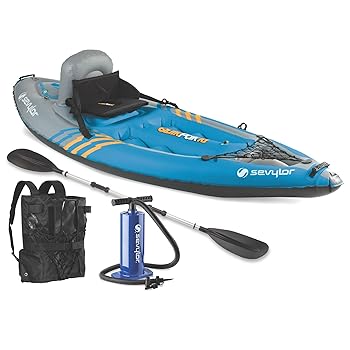
Lifetime 10 Foot
(Best Tandem Sit-On Kayak) 
Sevylor Coleman Colorado
(Best Fishing Kayak) 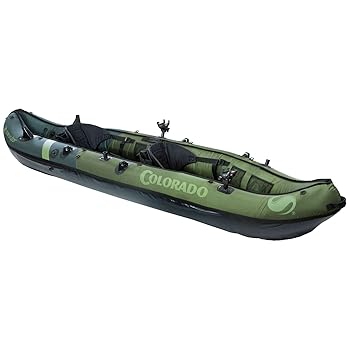
Ocean Kayak Malibu
(Best Sit-On-Top Recreational Kayak) 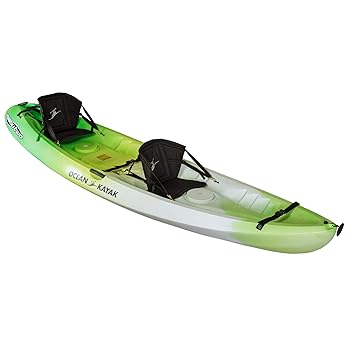
SUNDOLPHIN Sun Dolphin Excursion
(Best Sit-In Kayak) 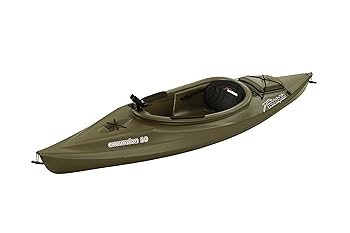
- Ultra-lightness (only 41 lbs.)
- Longer lasting after years of use and abuse compared to other kayaks.
Hence, aside from being a good choice for beginners, this is also a favorite pick of fishers as well. In fact, it’s integrated many functional components to serve for this purpose of use, such as one swivel rod holder, two flush mount rod holders, and one paddle holder. Besides, is a moderate cargo at the bow with a lid and shock cord deck rigging to keep everything dry and secure. From my experience, the Excursion is quite easy to climb in, paddle, turn, and get off with decent stability. It also doesn’t catch as much wind as the SOT kayaks, which is a big thumb up. However, I still recommend riding in calm waters only for the best safety.
Perception Pescador Pro
(Most User-Friendly Kayak) 
- The one-piece roto-molded construction that can resist UV rays, impact, saltwater corrosion, and abrasion efficiently
- The U.S. Coast Guard-compliant hull identification number for safety guarantee
The best thing is its SOT design keeps me drier than other counterparts in this field. It’s a big thank you to the sleek, fast and smooth hull which does a great job on covering lots of water with minimal water. Another compliment for the boat’s stability. Even when you’re standing on it, there’s no insecure feel of capsizing or tipping over. That excellent performance not only works on flat water like lakes or rivers but also on slow-moving flows or light waves as well. The only pity is no Pescador Paddles included in this set while they are really awesome in control and maneuverability. So, if your budget is loose, I highly recommend purchasing these accessories. No regret for sure!
Wilderness Systems Tarpon
(Most Versatile Kayak) 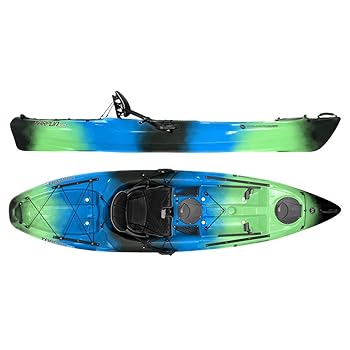
The Ultimate Guide To Choosing Best Kayak For Beginners In 2019
Type

- Sit-on-top (SOT)
- Inflatable
- Ocean
- Touring
- Racing
- Slalom
- White water
For beginners, I advise you to pick the SOT kayaks for two good reasons: Stability (due to its wider base) and Ease to get in/out of the boat (because of open cockpit design). Otherwise, it’s also comfortable to place your legs and roomy to take a child, dog along with your kayaking trip. Another option for novice kayakers is sit-in kayaks which are usually used in cold weather – something that a SOT boat can’t do. It’s also a favorite choice of those who don’t like their gear and themselves getting wet. In general, this kind of boat gives you more ease in mind against wind and waves thanks to its spray skirt and a lower center of gravity. Also, it’s very easy to paddle. Once you gain more experience, try other types of the kayak to fit your specific demands, while racing, white water, or fishing.
Material

- How it rides in the water
- The cost
- How heavy it is
For beginners, I recommend choosing the lightweight, durable, and affordable kind of material. “Lightweight” because it should be portable and easy to transport. “Durable” to withstand the abuse and punishment you’re about to put it through during a learning curve. And finally, “affordable” to save your bank. Actually, this time, it’s considered wasteful to invest in a too expensive kayak because there are too many functional features for a beginner to fully exploit fully. That’s why out of 7 common kinds of material for kayaks, including:
- Carbon fiber
- Fiberglass
- Wood
- ABS (Acrylonitrile-Butadiene-Styrene)
- Hard plastic
- Polyethylene
- Fabric with a frame
I only suggest two which are ABS and polyethylene. But also take note of their specific weaknesses. For example, polyethylene is prone to puncture when running into a sharp rock and it’s also susceptible to UV rays. About ABS, it’s better in UV resistance, weight, and some other mechanical aspects, but equivalently, the price will go up.
Length, Width, & Depth

Weight, Portability, & Storage
Whichever type of kayaks you’re going to choose, make sure it’s lightweight and collapsible. An inflatable kayak meets both these factors while keeping superior strength and durability to handles waves as good as the solid models. That’s why it’s always a favorite choice of 90% beginner kayakers. Not to mention that it’s much cheaper than other types of kayak and easier to transport.
Budget
You have heard me talk many times about starting with an affordable kayak. But how much is considered “affordable”? Well, in the market, the price of a kayak is varied within $150 to $2500. And for beginners, the range of $150-$1000 is reasonable.
Brands

- Ocean
- Lifetime
- Sevylor
- Sun Dolphin
- Perception
- Wilderness
FAQs
1. What is the best type of kayak for a beginner?
Out of many kayak types, the sit-on-top model is the best choice for beginners because of three major reasons:
- Affordability
- Superior stability
- Ease to get in/out of the boat
Besides, the sit-in kayaks are also worth considering based on their:
- Better performance in cold weather
- Keep riders and their gear dry
- Stay stable in waves and wind.
2. Are sit on top kayaks more stable?
Yes, they are. It’s because of the wider base, SOT kayaks are considered more stable for beginners to ride on.
3. What length of kayak do I need?
If you’re a beginner, I highly recommend choosing 6.5 to 10 feet. Otherwise, 11+-foot kayaks are a good choice for advanced kayakers.
Conclusion
Selecting the very first kayak is truly a big step because it will influence your experience, enjoyment, and how quick to learn kayaking. Overall, two solid things you should take into consideration are Durability and Stability. With all information, tips, and suggested options I’ve just shared you above, hopefully, they help you to figure out the best beginner kayak. Thanks for reading!
Leave a Reply